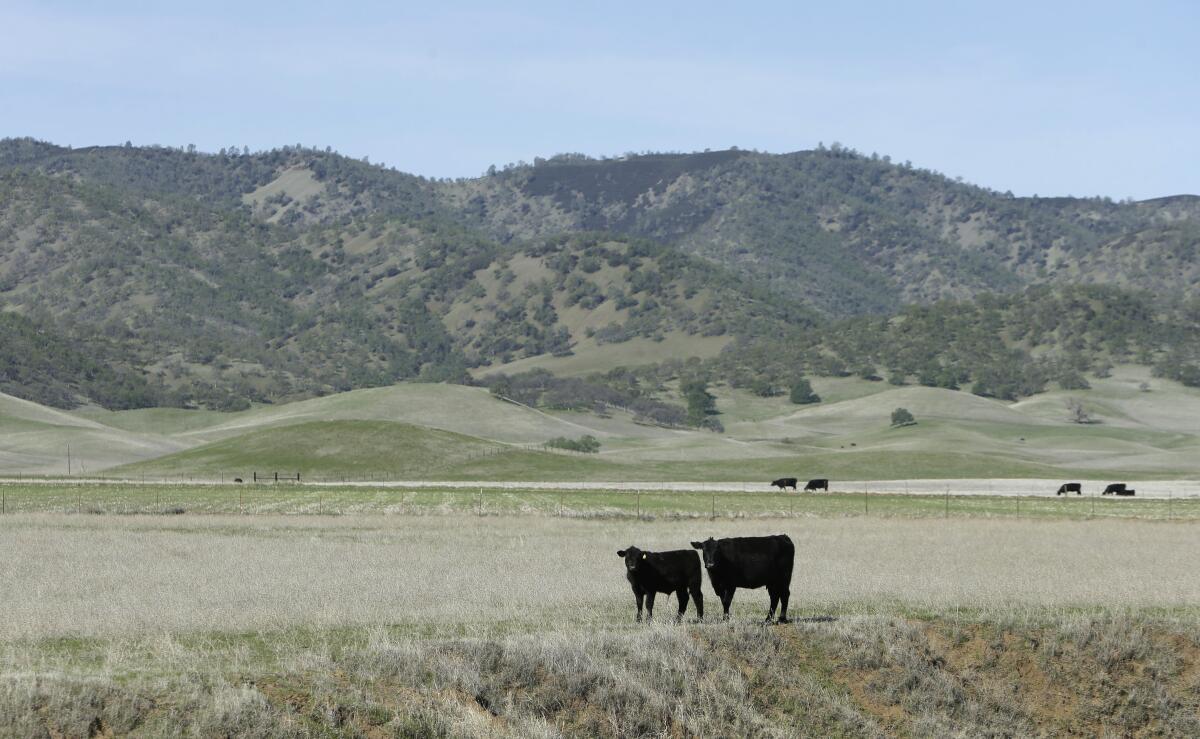This water project is expensive, wasteful and ecologically damaging. Why is it being fast-tracked?

- Share via
Noah Cross, the sinister plutocrat of the movie
“Chinatown,” remarked that “politicians, ugly buildings and whores all get respectable if they last long enough.”
He might have added public works projects to that list: If they get talked about long enough, sometimes they acquire the image of inevitability. That seems to be the case with the Sites Reservoir, a water project in the western Sacramento Valley that originated during the Eisenhower administration.
The project’s long sojourn on the drawing board should have been taken as a signal of its manifest flaws, which include its immense cost and its uncertain ability to contribute to the state’s water supplies — a contribution that has only become more dubious with the intensification of global warming.
This is probably the last gasp of the concept of California surface reservoirs.
— Peter Gleick, Pacific Institute
Instead, the project just received a priceless endorsement from Gov. Gavin Newsom, who on Nov. 6 certified it for fast-tracking under a new law that allows him to short-circuit court challenges to designated projects. Courts have only 270 days, or nine months, to decide legal challenges to those projects.
That might have been the only way to get the Sites project, which is estimated to cost $4.5 billion, up and running. Newsom’s action will clear the way for as much as $875.4 million in state funding to flow from the Proposition 1 state water bond that voters approved in 2014. The rest of the funding would come from the federal government and payments by the reservoir’s users.
Get the latest from Michael Hiltzik
Commentary on economics and more from a Pulitzer Prize winner.
You may occasionally receive promotional content from the Los Angeles Times.
The irony there is that the bond’s allocations for water storage are to go to environmentally beneficial storage projects. It’s doubtful that Sites would qualify under any honest assessment of its environmental impacts.
“This is miles from a project that would benefit the environment,” says Barry Nelson, a Berkeley water policy consultant. “It could be the nail in the coffin of the Bay-Delta ecosystem.”
Sites’ promoters paint the project’s putative environmental benefits with a broad brush. For example, they say it will provide “environmental water in drier periods for native fish and Pacific Flyway habitat for migratory birds and other native species.”
Is that right? The California Department of Fish and Wildlife didn’t think so in 2018, when it prepared an assessment of the project’s ecological impacts, especially as they applied to the salmon that spawn in the Northern California rivers. The agency said it had “low confidence in the magnitude of the ecosystem improvement” claimed by the promoters.
When a plant or species disappears for good in these modern times, it leaves behind a warning to our own species. Are we wise enough to hear it?
The agency was skeptical of claims that Sites would help to reduce water temperatures on the Feather and American rivers, where higher temperatures have been lethal for salmon spawn.
The promoters’ calculations showed temperature reductions of less than 1 degree Fahrenheit, a “relatively small change” that could not be shown to benefit the salmon population, the agency said. Indeed, under some circumstances and during some seasons, the project might even increase water temperatures.
The project has been somewhat scaled back since 2018 to ameliorate some of its environmental impacts, but its estimated cost hasn’t come down significantly.
The changes “moved it from a project that was catastrophic to one that is bad for the environment,” Nelson says, “but it sure isn’t a beneficial project.” Nevertheless, as currently designed, Sites would consume the largest share of the $2.7-billion that state voters approved for surface water storage projects in 2014.
Newsom and other Sites advocates have tried to justify the project with flagrantly misleading statistics. As Newsom said when announcing his certification, the reservoir would hold “up to 1.5 million acre-feet of water, enough for 3 million households’ yearly usage.”
That claim may have been accepted by some people who should know better, but it’s fakery, pure and simple. First, suggesting that the reservoir’s storage would serve “3 million households” is deceptive. As much as 80% of the water would be stored for the benefit of Central Valley growers, not urban residents.
Moreover, while 1.5 million acre-feet of water (about 488 billion gallons) may be equivalent to the consumption of about 3 million households, it’s not as if the entire capacity of Sites Reservoir would be available to serve the needs of all those families every year. The project managers say that annual deliveries would average only about 243,000 acre-feet a year, the equivalent of the usage of 490,000 households — if all the water were going to residential users.
Despite what you may have gleaned from television and the movies, zombies aren’t always constituted of flesh and blood.
Even if a full reservoir were drained to the last drop, recharging it to full capacity would take five to seven years, or as many as 10, to fill up again.
That brings us to the details of where and how Sites would be built.
Located on a 14,000-acre swath of grassland in Glenn and Colusa counties about 80 miles northwest of Sacramento, the reservoir is designed as off-stream storage — that is, it wouldn’t involve placing another dam directly on its source, the Sacramento River. Instead, it would involve a network of pumps, pipelines and dam to divert water from the river to the storage basin.
The diversions would only happen in wet years, when water in the Sacramento River is especially abundant — theoretically during surplus flows.
There lies another rub: Global warming is likely to mean longer drought spells between wet years in the Sacramento Valley.
“It’s only going to fill when there are really wet years and extra flow, and I don’t know how many really wet years we’re going to be getting in the future,” says Peter Gleick, an environmental scientist and co-founder of the Pacific Institute, a nonprofit environmental think tank. “History will have to show whether there will ever be enough water to make it worth the money that we’ll be putting into it.”
In the context of global warming, Sites Reservoir must be seen as an anachronism. California has essentially gotten out of the business of building surface reservoirs through damming — “this is probably the last gasp of the concept of California surface reservoirs,” Gleick told me.
As Reagan’s Interior secretary, Watt set the pattern of developing natural resources to benefit the chosen few and scoffing at ethics considerations.
The last major on-stream reservoir project in the state was New Melones Lake, which came online in 1978 with the damming of the Stanislaus River. That was followed by the construction of Diamond Valley Lake, an off-stream reservoir completed by the Metropolitan Water District of Southern California in 1999.
That brought to a close a dam-building era in California that had been launched in 1923 by the construction of O’Shaughnessy Dam, which flooded the picturesque Hetch Hetchy Valley to provide drinking water for San Francisco. In the interim, Californians built more than 800 dams.
By the end of that period, the outsized cost of building dams and the ecological damage they do was becoming recognized, as were options that are far more cost-effective, efficient and ecologically sound. Indeed, America as a whole has shifted to tearing dams down — more than 1,100 have been removed in recent years, in an effort to return the ecosystems that they spoiled to their pre-construction conditions.
The most effective programs to improve water supplies don’t require dams. “The smartest thing we can do is improve conservation and efficiency,” says Gleick, “to expand wastewater treatment and re-use, which we’re doing, and especially to figure out how to capture more stormwater not in surface reservoirs, but in groundwater. There needs to be a lot more of that. Those are the smartest, cheapest, fastest things we can do.”
The Sites promoters haven’t gotten the message that nature is trying to deliver. Their position is that climate change, which will increase the uncertainties of their water supply estimates, only underscores the wisdom of building Sites today.
“There is no time to waste and doing nothing while we wait for other actions to be completed is a sure way to continue the challenges we face today for decades into the future,” the project management says. They call it a “smart, 21st century tool to help California manage through droughts, climate change, and the stresses these conditions create for our natural and developed systems.”
It’s anything but. The smart, 21st century approach would be to leave Sites on the drawing board and turn to truly 21st century approaches, rather than trying to prop an outdated 70-year-old concept up on its shaky feet.
More to Read
Get the latest from Michael Hiltzik
Commentary on economics and more from a Pulitzer Prize winner.
You may occasionally receive promotional content from the Los Angeles Times.













